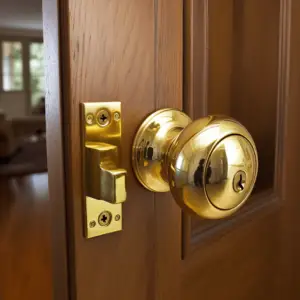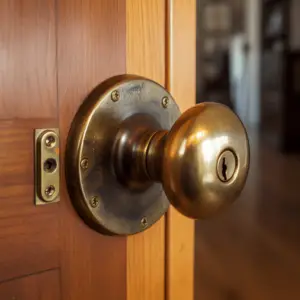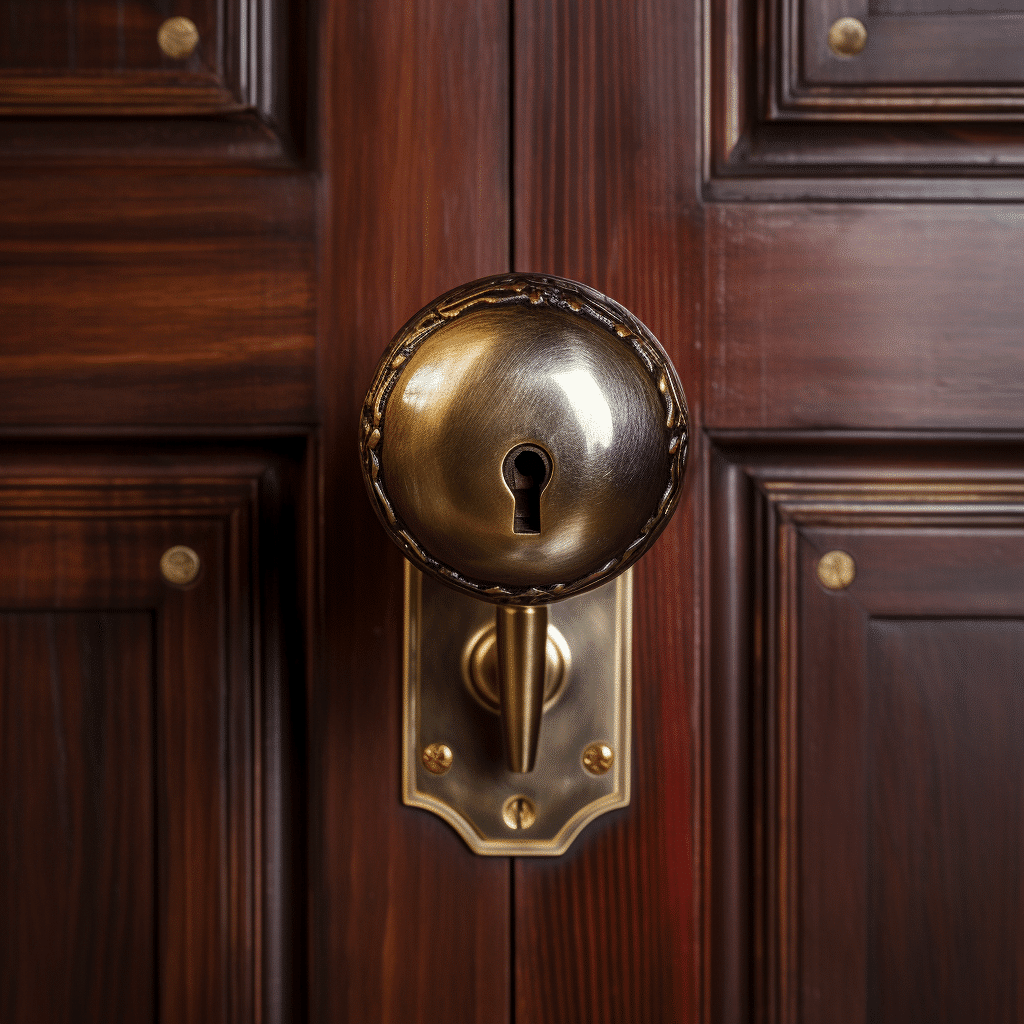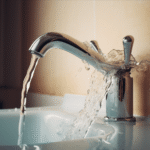Do you have a lock that won’t stay put? It can be very annoying! It’s not only dangerous for security, but it can also hurt people. Don’t be afraid! This guide will show you an easy way to fix it.
Check the screws first. If you move them a lot, they can get loose over time. Take off the cover plate and use a screwdriver to make sure the screws are tight.
Still don’t feel safe? There could be worn-out parts inside. Parts like the spindle or latch system may need to be replaced. Get help from a professional locksmith.
Take care when you fix it. Get help from a licensed locksmith or handyman if you aren’t sure how to do something or don’t feel safe using tools.
One last thing, energy inefficiency can also result from loose doorknobs! According to Energy.gov, if the door isn’t sealed well, drafts can enter your home or office, leading to higher heating/cooling bills.
Table of Contents
Understanding the problem

To fix a loose doorknob, understanding the problem is key. In this section, we’ll explore the causes of a loose doorknob. By identifying these factors, you can implement the appropriate solution for a stable and secure doorknob.
Causes of a loose doorknob
Have you noticed a loose doorknob? It could be caused by many different factors. Here are some common ones:
- Wear and tear: Repeated twisting and pulling can cause internal parts to loosen, resulting in a wobbly handle.
- Loose screws: If the screws connecting the knob to the door are not tightly fastened, it can lead to an unstable handle.
- Inadequate installation: If the knob is not securely attached to the spindle or latch mechanism, it may become shaky.
- Damaged interior components: Damage to internal parts, such as springs or bushings, can make the knob loose.
Other unique factors may be at play too. Get a pro to look at it quickly. Don’t wait until it’s completely off – take action now! Contact a locksmith or handyman to fix it fast. Secure doors are essential for your safety, so don’t leave yourself vulnerable. Act now and keep your home safe.
Tools and materials needed
To repair a loose doorknob, you need the right tools and materials. Here are five must-haves:
- A screwdriver with a fitting head for the screws.
- An Allen wrench for some doorknobs.
- New screws in case the old ones are stripped or damaged.
- Lubricant to ease any stuck parts.
- Safety glasses for any debris or flying fragments.
Plus, you may want to use a step-by-step guide for your specific doorknob model. Amazingly, Home Repair Tutor claims you can finish in less than 30 minutes!
Preparing to fix the loose doorknob
To ensure a successful fix for your loose doorknob, follow these steps for preparing the necessary tools and workspace. Take the necessary safety precautions to protect yourself and your surroundings as you dive into this home improvement project.
Safety precautions
Always take safety precautions! Follow these steps to ensure your safety:
- Cut the power supply to avoid any electrical hazards.
- Put on protective gloves and safety glasses.
- Get a stable ladder or step stool to reach high places.
- Don’t use too much force while tightening or removing screws.
- Follow manufacturer guidelines for the specific doorknob model.
I recently saw someone try to repair a loose doorknob without switching off the power supply. They got an electric shock! Thankfully, no severe injuries, but it was a reminder of how important it is to take safety seriously.
Step-by-step instructions
To fix a loose doorknob, follow the step-by-step instructions below. Remove the doorknob cover, tighten the screws, check for any additional loose parts, and reassemble the doorknob. Each sub-section provides a solution for each step, enabling you to successfully address the issue without any hassle.
Step 1: Remove the doorknob cover
Removing a doorknob cover can seem hard, but with some steps, it’s easy! Here’s how:
- Locate the hole on the cover.
- Put in a thin object like a screwdriver or paperclip, and press down.
- Twist or turn the knob counterclockwise while applying pressure.
- Once it releases, pull it out. Be careful not to use too much force.
- You may need to access screws underneath.
Remember to be careful. Different brands and models may have variations in the removal process, so read the manufacturer’s instructions.
One day, I attempted to remove a stubborn doorknob cover. I followed generic instructions, but it didn’t work. So, I called a locksmith. He solved the problem quickly and expertly. It was a reminder that it’s best to leave certain tasks to professionals!
Step 2: Tighten the screws
Tightening screws is a must. To get the job done right, follow these steps!
- Gather screwdriver and other tools mentioned in project guidelines.
- Find screws that need tightening. Note their positions and make sure you can reach them.
- Use the right size screwdriver for the screws. Stop stripping and damaging them.
- Put screwdriver into slot of screw and turn clockwise with pressure. Don’t overtighten.
- Do this process for each screw, following patterns or sequences from instructions.
- Check your work by testing each tightened screw. If any feel loose, repeat steps 3-5.
Tightening screws provides stability and long-term performance. Follow instructions and achieve the best results.
Different projects may ask for adjustments based on weight or other hardware needs. Read project documentation for details.
Centuries ago, ancient Egyptians were already using joinery techniques. They secured furniture with brass-tipped pegs, similar to modern screws.
Since then, fastening components tightly has been a priority. Techniques have evolved over time, striving for perfection.
Step 3: Check for any additional loose parts
Inspecting for loose pieces is a must for a safe and secure assembly. Fasteners need to be tight and the area should be checked for anything that could cause damage or injury. Carefully inspect each section.
Here’s a 3-step guide:
- Visually examine all parts for looseness or detachment. Note any issues for further investigation.
- Physically assess with hands/tools, wiggling/tugging to find hidden weaknesses.
- Apply pressure on connections/joints to confirm their stability.
Unique aspects in your setup may require extra attention.
An interesting fact: in 1937, engineers found loose bolts in San Francisco’s Golden Gate Bridge, leading to corrective action. Diligence is key for safety and quality in any assembly project.
Step 4: Reassemble the doorknob
Reassembling a doorknob may seem hard, but with the right direction it can be a breeze! Here are the steps to put your doorknob back together:
- Gather all the parts needed – the doorknob, screws, and other components.
- Check each part for damage or wear. Replace any parts that need it.
- Line up the doorknob spindle with the latch mechanism on the door. It may take some adjusting to get it right.
- Secure the doorknob onto the door by tightening the screws. Don’t overtighten – it could damage the doorknob.
- Test the doorknob by turning it and making sure it locks and unlocks properly.
- Polish the doorknob with a soft cloth to remove fingerprints.
For a successful reassembly, remember:
- Remember how you disassembled the parts.
- Handle small parts carefully to avoid losing them.
- Lubricate moving parts for a smooth operation.
By following these steps and tips, you can easily reassemble your doorknob and get it working again.
Additional tips and considerations

When fixing a wobbly doorknob, there are some extra tips to keep in mind. They will ensure the repair is successful and lasting.
- Check the entire door frame for any other loose or broken components, like hinges or plates.
- Use a screwdriver with a magnetic tip for easy removal and attachment of screws.
- Maybe use thread locker if the problem persists after tightening the screws.
- Put lubricant or graphite powder inside the doorknob to reduce friction.
- For older or complex doorknobs, consult the manufacturer’s instructions or seek help.
- Once done, test the doorknob to make sure it is no longer loose.
Also, remember that different types of doorknobs need specific tools or techniques to repair. Research your particular doorknob model before attempting repairs.
Did you know? Building structure settling can cause loose doorknobs, according to Home Depot.
Conclusion
It’s easy to fix a loose lock. Just tighten the screws carefully and make sure the parts are in the right place. Problems won’t happen again if you do regular upkeep and look for signs of damage. Also, keep in mind that a lock that isn’t tight can be dangerous. It can hurt privacy and security.
Doorknobs have been around for 5,000 years, which is very interesting! Ancient Egyptians used door handles made of wood, stone, and metal so they could get in and out of their homes more easily and keep them safer.
Frequently Asked Questions
1. How do I determine the cause of a loose doorknob?
To figure out why a doorknob is loose, you should first look at the screws that hold it to the door. If they are loose, use a screwdriver to fix them. If the screws are tight, the problem may be with the device inside the knob, in which case you may need to take it apart.
2. Can I fix a loose doorknob without removing it?
Yes, you can try tightening the screws of a loose doorknob without removing it. Use a screwdriver to tighten all visible screws on the knob and plate. If this doesn’t solve the problem, you may need to take the doorknob off to further inspect and repair it.
3. How do I remove a doorknob to fix it?
Find a small slot or hole on a doorknob to take it off. Press a key or thin item into the hole and turn the knob in the opposite direction of the clock. This should free the knob so you can take it off. Once you take it apart, you can figure out what went wrong and fix it.
4. What can I do if the doorknob’s mechanism is damaged?
If the device inside the doorknob is broken, you may need to replace it. Most shops that sell hardware have replacement parts that are easy to put in. Just take out the old mechanism and put in the new one, following the directions from the manufacturer.
5. Can I use adhesive or glue to fix a loose doorknob?
Using glue or an adhesive to fix a loose lock is not a good idea. It might work for a short time, but it can weaken over time and cause more problems. For a fix that will last, it’s best to tighten or fix the parts of the lock correctly.
6. When should I call a professional for help?
If you’ve tightened screws, checked the mechanism, and replaced parts, but the doorknob is still loose, you may need to call an expert. A skilled locksmith or plumber can figure out what’s wrong and come up with a good way to fix the loose doorknob.


